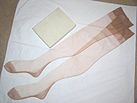Loose sock: Difference between revisions
No edit summary |
removed contradiction |
||
| Line 2: | Line 2: | ||
| unreferenced = February 2007 |
| unreferenced = February 2007 |
||
| inappropriate tone = December 2007 |
| inappropriate tone = December 2007 |
||
| contradict = May 2007 |
|||
}} |
}} |
||
[[Image:loosesockswp.jpg|thumbnail|Loose socks in Japan]] |
[[Image:loosesockswp.jpg|thumbnail|Loose socks in Japan]] |
||
Revision as of 05:35, 10 January 2009
This article has multiple issues. Please help improve it or discuss these issues on the talk page. (Learn how and when to remove these messages)
No issues specified. Please specify issues, or remove this template. |

Loose socks (Japanese: ルーズソックス, rūzu sokkusu) are a type of sock that was popular among Japanese high school girls. They originated from boot socks for mountain climbing, manufactured in and exported from the United States.
In Japan, they were adopted as a fashion that deviated from school uniforms and firmly took root after a long period of popularity.
They were first worn by high school girls and later by junior high school girls, but not other ages. The fashion is so unpopular with other age groups that it is said that loose socks equal high school girls. Since the socks are worn to go with school uniforms, they generally haven't come into fashion with elementary school students. There are also virtually no girls who keep wearing loose socks after they graduate from high school. Those who do tend to be viewed as strange.
Because loose socks are bought by 12–18-year-old girls almost exclusively, they are not considered to be a big earner in the clothing industry when compared to other kinds of clothing and thus are not marketed aggressively.
In Japan, loose socks have been in fashion since the early 1990s and are still popular.
Method
The socks originally imported to Japan were not loose at all but were thick and voluminous. For those who wanted to wear them loosely, these socks were stretched out by the owners before the popularity and mass production of loose socks.
They are nearly always white, though black and navy blue ones also exist. Generally, they are larger than normal socks. To wear them, one stretches them out and puts them on. They are usually worn below the knee, held up with an adhesive called sock glue and sock touch*, and somewhat resemble leg warmers, with the difference being that leg warmers do not go below the ankles. Loose socks are often paired with skirts above the knee and a pair of mary janes or loafers.
* Sock touch is a registered trademark of Hakugen.
Birth and establishment
At the beginning of the 1990s, it became fashionable for Japanese high school girls to shorten their skirts. In the mid-90s, they wore imported mountain-climbing boot socks to accent their exposed legs (or perhaps as a countermeasure against the cold). These socks were manufactured by such sock makers as America's E.G. Smith. It is not known if there was a time when loose socks were called "boot socks," but they quickly became referred to as "loose socks" and, together with miniskirts, became an established fashion.
The two most well-known views are that the fashion originated in Sendai, Miyagi or in Mito, Ibaraki. In both stories, to protect against the cold, girls bought, loosened, and wore large socks. It is said that they became popular because they made fat legs look thin. After that, the socks became established merchandise and spread to major cities such as Tokyo and Osaka, and then throughout the whole country. They rapidly gained popularity, chiefly with high school girls.
The height of loose socks' popularity was from 1996 to 1998. Furthermore, in that period varieties such as "super loose" and "gom nuki loose" (loose socks with the elastic removed) were born. There were even socks two meters long. These were mainly worn by the yamamba gal subculture. Some schools forbade pupils to wear loose socks at school, so girls would often change into loose socks and wear them outside the school campus. This sort of trend was picked up on by the mass media, which brought attention to loose socks as emblematic items of high school girl culture.
After 1998, the fad ended. Though it had ended as a fad, there were still people who wore loose socks as an established fashion. It is guessed that the reasons why the fad ended are that people wanted to try different fashions and that there was a bad feeling toward the fad. Some schools enacted rules enforcing the wearing of knee socks, others made definitive statements forbidding loose socks, and so forth. It is thought that this correspondence from schools has had an influence. Since about 2000, regular navy blue knee socks have been comparatively spreading.
Yet, in 2006 even though loose socks are no longer prevalent, they are experiencing a resurgence among girls whose distinguishing characteristics are gaudy makeup and clothing, and the number of people wearing them is increasing. Also, they are still becoming popular worldwide. E.G. Smith, who sells boot socks for mountain-climbing, continues to sell socks aimed at females. However, high school girls now wear white or navy blue knee socks to go with their uniforms. One rarely sees loose socks at schools anymore.

